Report on the Financial Analysis of Cartagena Coffee Business
VerifiedAdded on 2020/03/23
|7
|1347
|143
Report
AI Summary
This report analyzes the coffee business Cartagena, owned by Adam and Virginia, focusing on financial performance and decision-making. It computes accounting and economic profits before and after penalty rate cuts, highlighting the differences between them, particularly emphasizing the impact of opportunity cost. The report also calculates average and sunk costs, while assessing the price elasticity of demand for the coffee service. The analysis reveals that while accounting profit remains constant, economic profit increases after the penalty rate cut. The report concludes that the business's decision to maintain a production level of 4000 cups is rational, considering market dynamics and the high price elasticity of demand. The report also includes appendix tables detailing the financial data used in the analysis.
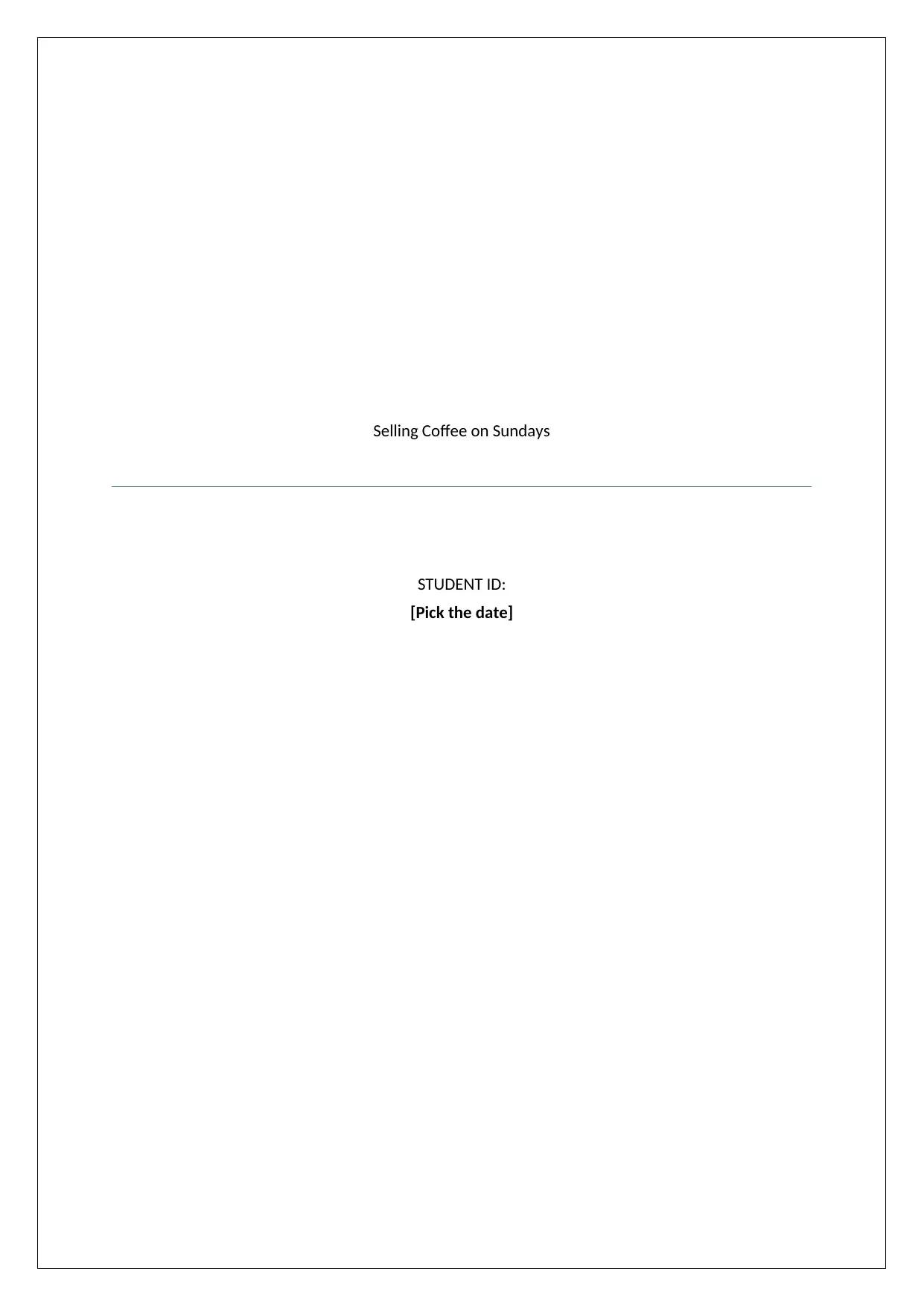
Selling Coffee on Sundays
STUDENT ID:
[Pick the date]
STUDENT ID:
[Pick the date]
Paraphrase This Document
Need a fresh take? Get an instant paraphrase of this document with our AI Paraphraser
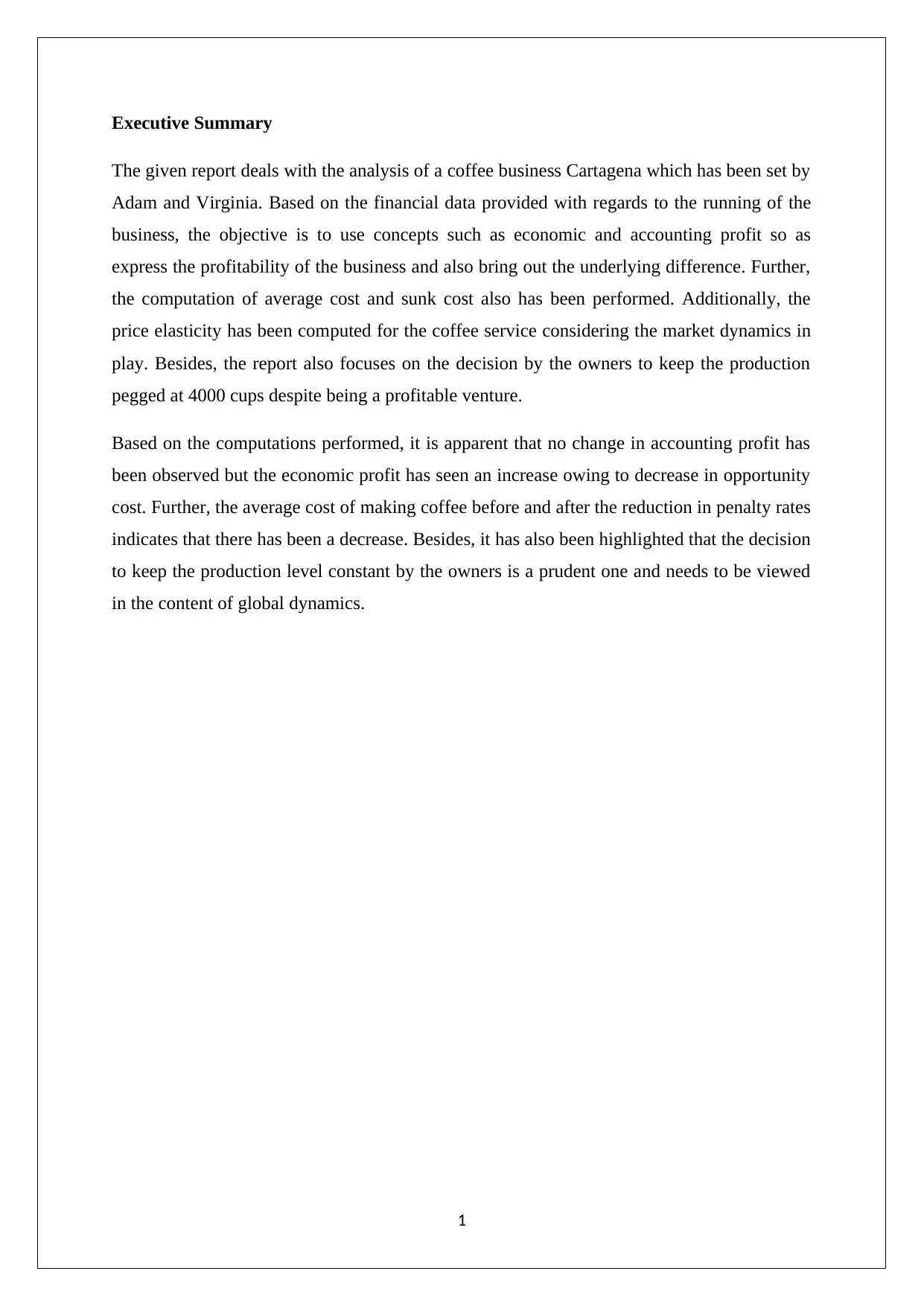
Executive Summary
The given report deals with the analysis of a coffee business Cartagena which has been set by
Adam and Virginia. Based on the financial data provided with regards to the running of the
business, the objective is to use concepts such as economic and accounting profit so as
express the profitability of the business and also bring out the underlying difference. Further,
the computation of average cost and sunk cost also has been performed. Additionally, the
price elasticity has been computed for the coffee service considering the market dynamics in
play. Besides, the report also focuses on the decision by the owners to keep the production
pegged at 4000 cups despite being a profitable venture.
Based on the computations performed, it is apparent that no change in accounting profit has
been observed but the economic profit has seen an increase owing to decrease in opportunity
cost. Further, the average cost of making coffee before and after the reduction in penalty rates
indicates that there has been a decrease. Besides, it has also been highlighted that the decision
to keep the production level constant by the owners is a prudent one and needs to be viewed
in the content of global dynamics.
1
The given report deals with the analysis of a coffee business Cartagena which has been set by
Adam and Virginia. Based on the financial data provided with regards to the running of the
business, the objective is to use concepts such as economic and accounting profit so as
express the profitability of the business and also bring out the underlying difference. Further,
the computation of average cost and sunk cost also has been performed. Additionally, the
price elasticity has been computed for the coffee service considering the market dynamics in
play. Besides, the report also focuses on the decision by the owners to keep the production
pegged at 4000 cups despite being a profitable venture.
Based on the computations performed, it is apparent that no change in accounting profit has
been observed but the economic profit has seen an increase owing to decrease in opportunity
cost. Further, the average cost of making coffee before and after the reduction in penalty rates
indicates that there has been a decrease. Besides, it has also been highlighted that the decision
to keep the production level constant by the owners is a prudent one and needs to be viewed
in the content of global dynamics.
1
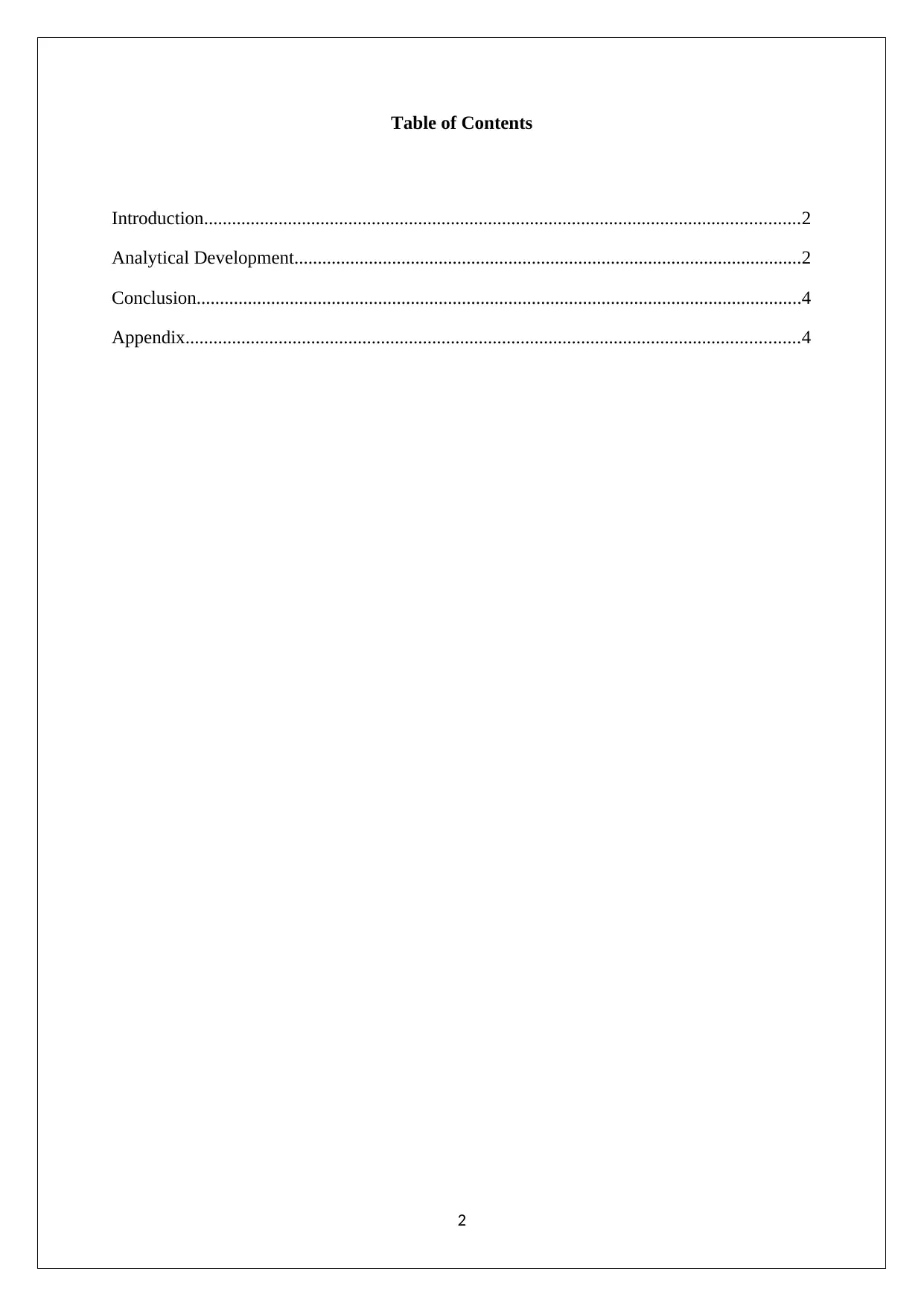
Table of Contents
Introduction................................................................................................................................2
Analytical Development.............................................................................................................2
Conclusion..................................................................................................................................4
Appendix....................................................................................................................................4
2
Introduction................................................................................................................................2
Analytical Development.............................................................................................................2
Conclusion..................................................................................................................................4
Appendix....................................................................................................................................4
2
⊘ This is a preview!⊘
Do you want full access?
Subscribe today to unlock all pages.

Trusted by 1+ million students worldwide
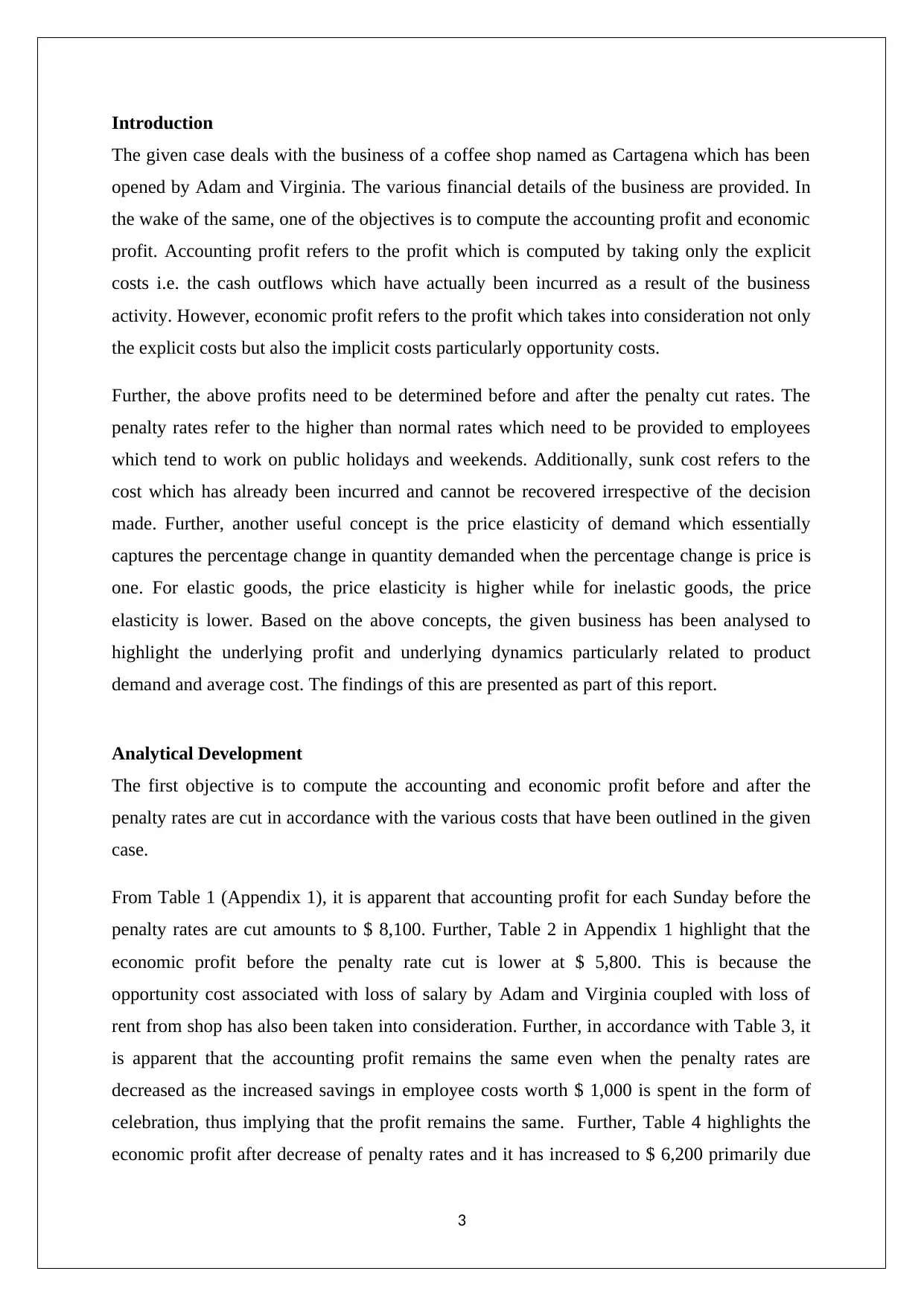
Introduction
The given case deals with the business of a coffee shop named as Cartagena which has been
opened by Adam and Virginia. The various financial details of the business are provided. In
the wake of the same, one of the objectives is to compute the accounting profit and economic
profit. Accounting profit refers to the profit which is computed by taking only the explicit
costs i.e. the cash outflows which have actually been incurred as a result of the business
activity. However, economic profit refers to the profit which takes into consideration not only
the explicit costs but also the implicit costs particularly opportunity costs.
Further, the above profits need to be determined before and after the penalty cut rates. The
penalty rates refer to the higher than normal rates which need to be provided to employees
which tend to work on public holidays and weekends. Additionally, sunk cost refers to the
cost which has already been incurred and cannot be recovered irrespective of the decision
made. Further, another useful concept is the price elasticity of demand which essentially
captures the percentage change in quantity demanded when the percentage change is price is
one. For elastic goods, the price elasticity is higher while for inelastic goods, the price
elasticity is lower. Based on the above concepts, the given business has been analysed to
highlight the underlying profit and underlying dynamics particularly related to product
demand and average cost. The findings of this are presented as part of this report.
Analytical Development
The first objective is to compute the accounting and economic profit before and after the
penalty rates are cut in accordance with the various costs that have been outlined in the given
case.
From Table 1 (Appendix 1), it is apparent that accounting profit for each Sunday before the
penalty rates are cut amounts to $ 8,100. Further, Table 2 in Appendix 1 highlight that the
economic profit before the penalty rate cut is lower at $ 5,800. This is because the
opportunity cost associated with loss of salary by Adam and Virginia coupled with loss of
rent from shop has also been taken into consideration. Further, in accordance with Table 3, it
is apparent that the accounting profit remains the same even when the penalty rates are
decreased as the increased savings in employee costs worth $ 1,000 is spent in the form of
celebration, thus implying that the profit remains the same. Further, Table 4 highlights the
economic profit after decrease of penalty rates and it has increased to $ 6,200 primarily due
3
The given case deals with the business of a coffee shop named as Cartagena which has been
opened by Adam and Virginia. The various financial details of the business are provided. In
the wake of the same, one of the objectives is to compute the accounting profit and economic
profit. Accounting profit refers to the profit which is computed by taking only the explicit
costs i.e. the cash outflows which have actually been incurred as a result of the business
activity. However, economic profit refers to the profit which takes into consideration not only
the explicit costs but also the implicit costs particularly opportunity costs.
Further, the above profits need to be determined before and after the penalty cut rates. The
penalty rates refer to the higher than normal rates which need to be provided to employees
which tend to work on public holidays and weekends. Additionally, sunk cost refers to the
cost which has already been incurred and cannot be recovered irrespective of the decision
made. Further, another useful concept is the price elasticity of demand which essentially
captures the percentage change in quantity demanded when the percentage change is price is
one. For elastic goods, the price elasticity is higher while for inelastic goods, the price
elasticity is lower. Based on the above concepts, the given business has been analysed to
highlight the underlying profit and underlying dynamics particularly related to product
demand and average cost. The findings of this are presented as part of this report.
Analytical Development
The first objective is to compute the accounting and economic profit before and after the
penalty rates are cut in accordance with the various costs that have been outlined in the given
case.
From Table 1 (Appendix 1), it is apparent that accounting profit for each Sunday before the
penalty rates are cut amounts to $ 8,100. Further, Table 2 in Appendix 1 highlight that the
economic profit before the penalty rate cut is lower at $ 5,800. This is because the
opportunity cost associated with loss of salary by Adam and Virginia coupled with loss of
rent from shop has also been taken into consideration. Further, in accordance with Table 3, it
is apparent that the accounting profit remains the same even when the penalty rates are
decreased as the increased savings in employee costs worth $ 1,000 is spent in the form of
celebration, thus implying that the profit remains the same. Further, Table 4 highlights the
economic profit after decrease of penalty rates and it has increased to $ 6,200 primarily due
3
Paraphrase This Document
Need a fresh take? Get an instant paraphrase of this document with our AI Paraphraser
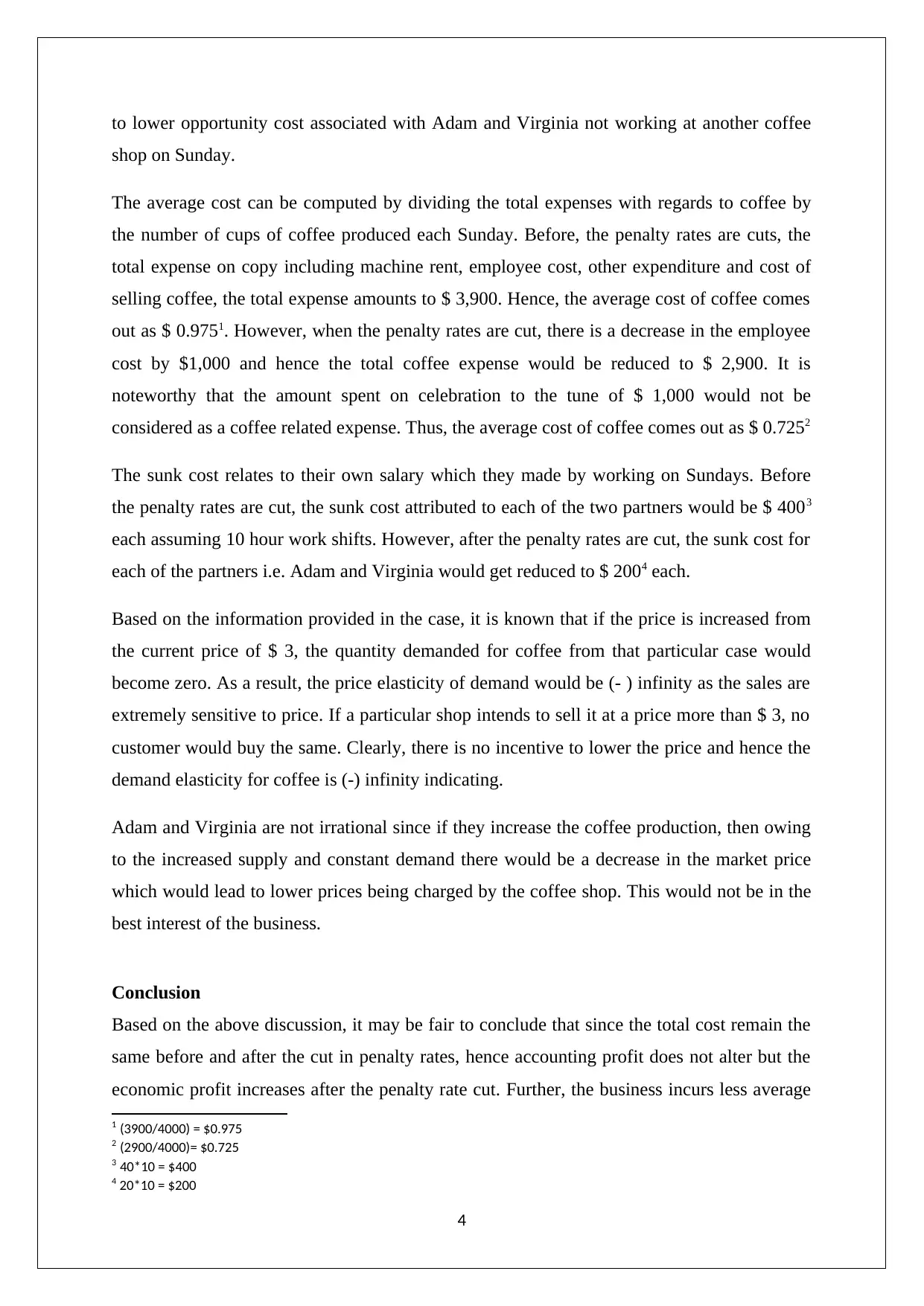
to lower opportunity cost associated with Adam and Virginia not working at another coffee
shop on Sunday.
The average cost can be computed by dividing the total expenses with regards to coffee by
the number of cups of coffee produced each Sunday. Before, the penalty rates are cuts, the
total expense on copy including machine rent, employee cost, other expenditure and cost of
selling coffee, the total expense amounts to $ 3,900. Hence, the average cost of coffee comes
out as $ 0.9751. However, when the penalty rates are cut, there is a decrease in the employee
cost by $1,000 and hence the total coffee expense would be reduced to $ 2,900. It is
noteworthy that the amount spent on celebration to the tune of $ 1,000 would not be
considered as a coffee related expense. Thus, the average cost of coffee comes out as $ 0.7252
The sunk cost relates to their own salary which they made by working on Sundays. Before
the penalty rates are cut, the sunk cost attributed to each of the two partners would be $ 4003
each assuming 10 hour work shifts. However, after the penalty rates are cut, the sunk cost for
each of the partners i.e. Adam and Virginia would get reduced to $ 2004 each.
Based on the information provided in the case, it is known that if the price is increased from
the current price of $ 3, the quantity demanded for coffee from that particular case would
become zero. As a result, the price elasticity of demand would be (- ) infinity as the sales are
extremely sensitive to price. If a particular shop intends to sell it at a price more than $ 3, no
customer would buy the same. Clearly, there is no incentive to lower the price and hence the
demand elasticity for coffee is (-) infinity indicating.
Adam and Virginia are not irrational since if they increase the coffee production, then owing
to the increased supply and constant demand there would be a decrease in the market price
which would lead to lower prices being charged by the coffee shop. This would not be in the
best interest of the business.
Conclusion
Based on the above discussion, it may be fair to conclude that since the total cost remain the
same before and after the cut in penalty rates, hence accounting profit does not alter but the
economic profit increases after the penalty rate cut. Further, the business incurs less average
1 (3900/4000) = $0.975
2 (2900/4000)= $0.725
3 40*10 = $400
4 20*10 = $200
4
shop on Sunday.
The average cost can be computed by dividing the total expenses with regards to coffee by
the number of cups of coffee produced each Sunday. Before, the penalty rates are cuts, the
total expense on copy including machine rent, employee cost, other expenditure and cost of
selling coffee, the total expense amounts to $ 3,900. Hence, the average cost of coffee comes
out as $ 0.9751. However, when the penalty rates are cut, there is a decrease in the employee
cost by $1,000 and hence the total coffee expense would be reduced to $ 2,900. It is
noteworthy that the amount spent on celebration to the tune of $ 1,000 would not be
considered as a coffee related expense. Thus, the average cost of coffee comes out as $ 0.7252
The sunk cost relates to their own salary which they made by working on Sundays. Before
the penalty rates are cut, the sunk cost attributed to each of the two partners would be $ 4003
each assuming 10 hour work shifts. However, after the penalty rates are cut, the sunk cost for
each of the partners i.e. Adam and Virginia would get reduced to $ 2004 each.
Based on the information provided in the case, it is known that if the price is increased from
the current price of $ 3, the quantity demanded for coffee from that particular case would
become zero. As a result, the price elasticity of demand would be (- ) infinity as the sales are
extremely sensitive to price. If a particular shop intends to sell it at a price more than $ 3, no
customer would buy the same. Clearly, there is no incentive to lower the price and hence the
demand elasticity for coffee is (-) infinity indicating.
Adam and Virginia are not irrational since if they increase the coffee production, then owing
to the increased supply and constant demand there would be a decrease in the market price
which would lead to lower prices being charged by the coffee shop. This would not be in the
best interest of the business.
Conclusion
Based on the above discussion, it may be fair to conclude that since the total cost remain the
same before and after the cut in penalty rates, hence accounting profit does not alter but the
economic profit increases after the penalty rate cut. Further, the business incurs less average
1 (3900/4000) = $0.975
2 (2900/4000)= $0.725
3 40*10 = $400
4 20*10 = $200
4
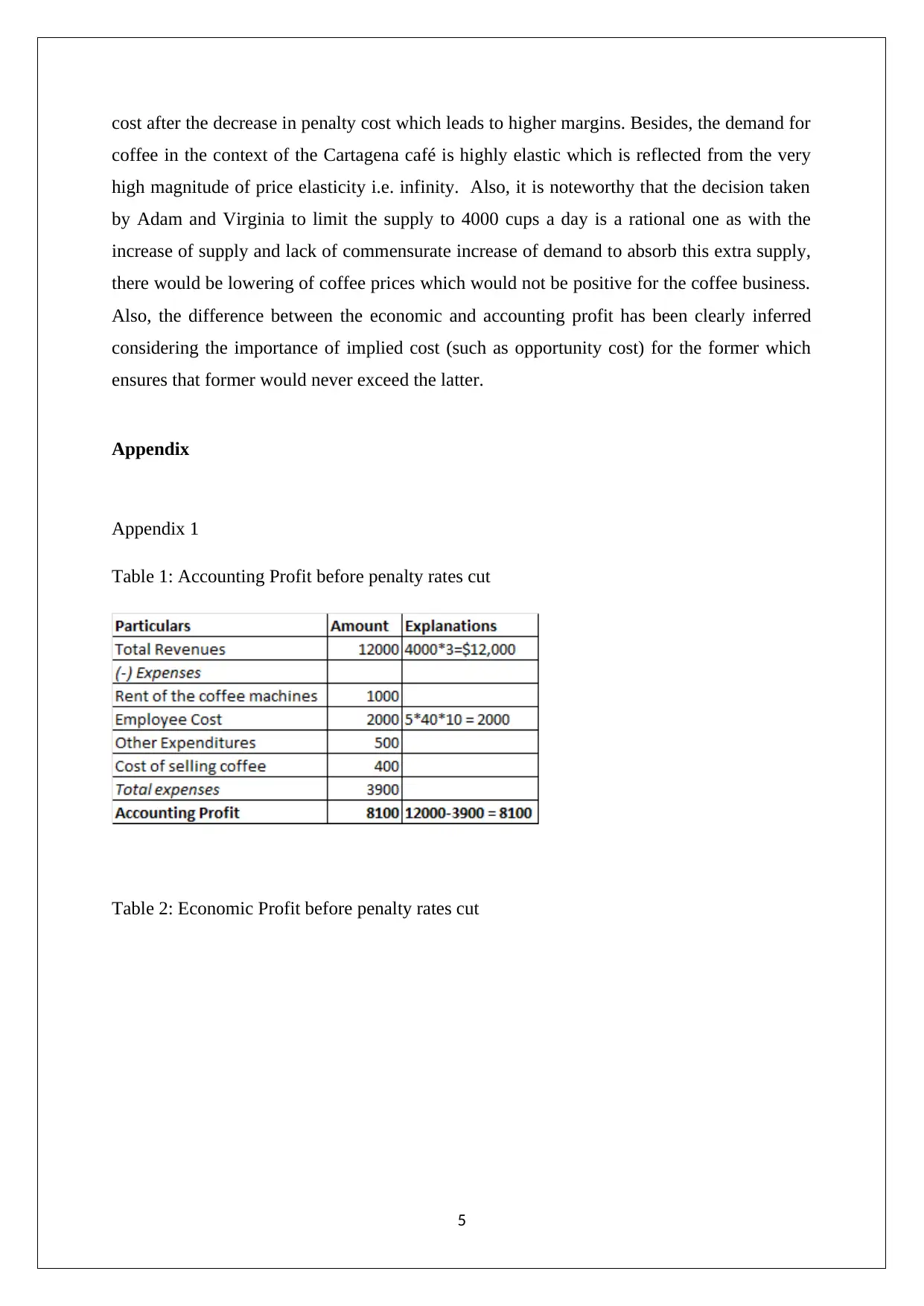
cost after the decrease in penalty cost which leads to higher margins. Besides, the demand for
coffee in the context of the Cartagena café is highly elastic which is reflected from the very
high magnitude of price elasticity i.e. infinity. Also, it is noteworthy that the decision taken
by Adam and Virginia to limit the supply to 4000 cups a day is a rational one as with the
increase of supply and lack of commensurate increase of demand to absorb this extra supply,
there would be lowering of coffee prices which would not be positive for the coffee business.
Also, the difference between the economic and accounting profit has been clearly inferred
considering the importance of implied cost (such as opportunity cost) for the former which
ensures that former would never exceed the latter.
Appendix
Appendix 1
Table 1: Accounting Profit before penalty rates cut
Table 2: Economic Profit before penalty rates cut
5
coffee in the context of the Cartagena café is highly elastic which is reflected from the very
high magnitude of price elasticity i.e. infinity. Also, it is noteworthy that the decision taken
by Adam and Virginia to limit the supply to 4000 cups a day is a rational one as with the
increase of supply and lack of commensurate increase of demand to absorb this extra supply,
there would be lowering of coffee prices which would not be positive for the coffee business.
Also, the difference between the economic and accounting profit has been clearly inferred
considering the importance of implied cost (such as opportunity cost) for the former which
ensures that former would never exceed the latter.
Appendix
Appendix 1
Table 1: Accounting Profit before penalty rates cut
Table 2: Economic Profit before penalty rates cut
5
⊘ This is a preview!⊘
Do you want full access?
Subscribe today to unlock all pages.

Trusted by 1+ million students worldwide
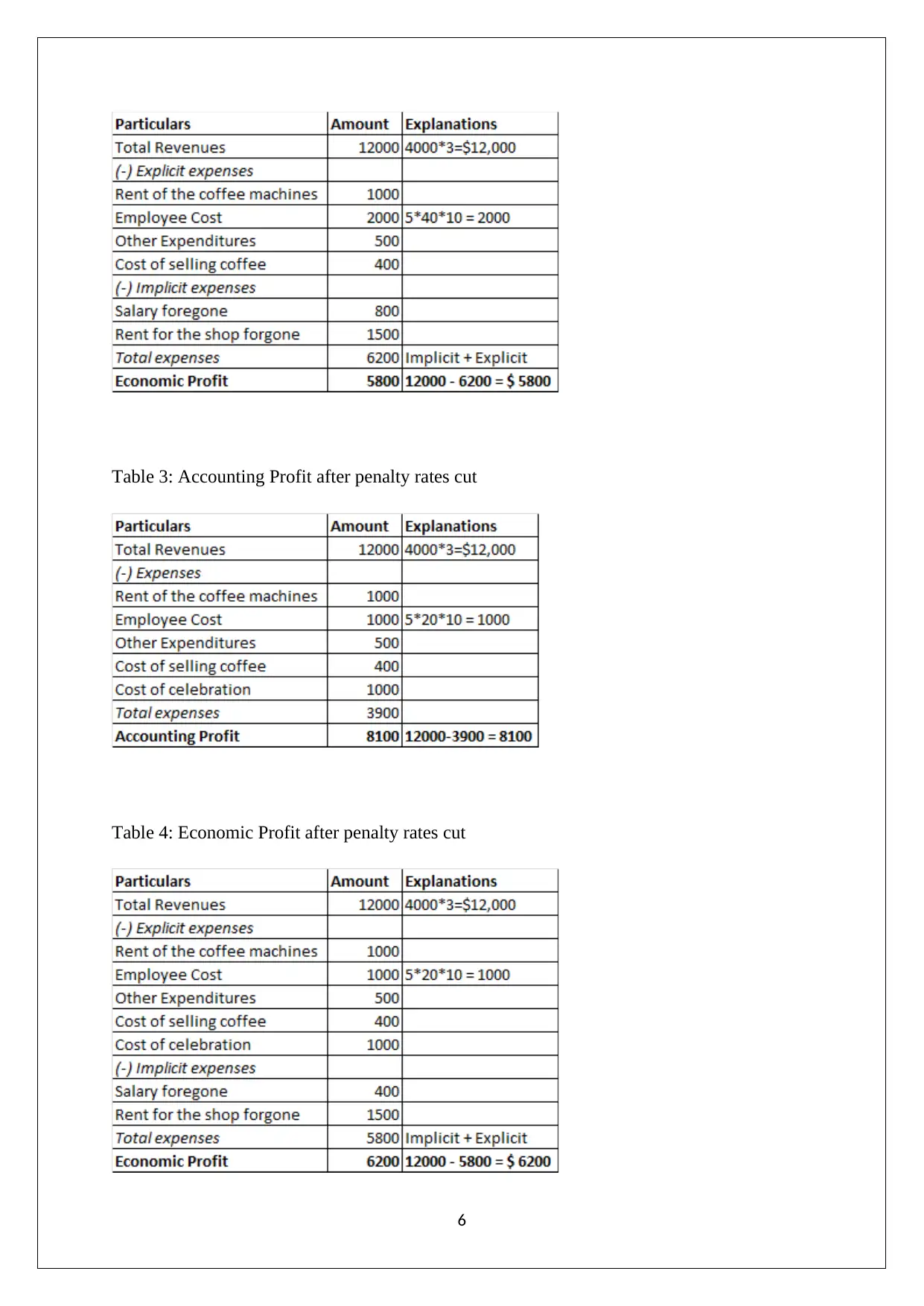
Table 3: Accounting Profit after penalty rates cut
Table 4: Economic Profit after penalty rates cut
6
Table 4: Economic Profit after penalty rates cut
6
1 out of 7
Related Documents
Your All-in-One AI-Powered Toolkit for Academic Success.
+13062052269
info@desklib.com
Available 24*7 on WhatsApp / Email
![[object Object]](/_next/static/media/star-bottom.7253800d.svg)
Unlock your academic potential
Copyright © 2020–2025 A2Z Services. All Rights Reserved. Developed and managed by ZUCOL.




